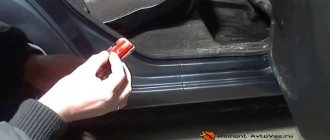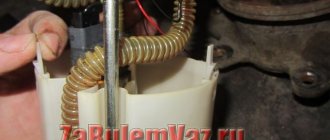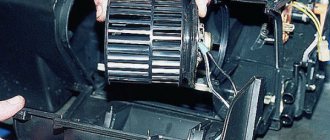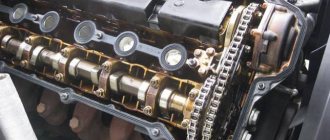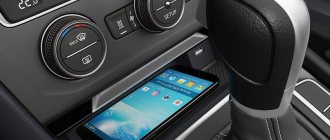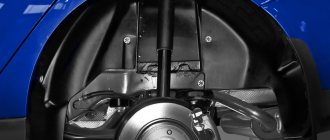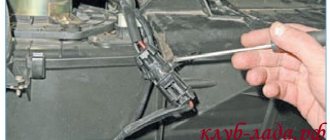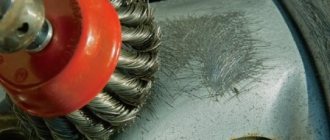From experienced motorists you can often hear the expression “you need to treat the bottom with Movil.” Many of them sit in the garage for hours and carry out some manipulations with this product, or “movil”, simply put. Is it really that good?! Or are these simply remnants of the socialist era, in which there were simply no other types of anticorrosion agents. It's time to dot the i's and clarify this issue.
Composition, characteristics and principle of action of Movil
The abbreviation “MoVil” was formed from the names of the cities (Moscow and Vilnius) in which this anti-corrosion composition was first created. Now Movil is not a specific product, but a whole direction in the production of anti-rust products, which are produced by various companies in Russia and the CIS countries.
Movil is understood as a universal anticorrosive agent in the form of a liquid, spray, paste of black or dark brown color, intended for treating the body and hidden cavities of the car. The product will also help keep the elements of the machine intact and protect them from rust if it has to be preserved.
The composition of the product is quite complex. It is represented by the following ingredients:
- white spirit solvent;
- paraffin;
- zinc;
- machine oil;
- calcium sulfonate;
- kerosene;
- drying oil;
- modifying additives;
- corrosion inhibitors;
- thixotropic substances;
- additives for displacing moisture;
- deodorizing components.
Movil is suitable for any base materials, fits well on painted and unpainted surfaces, and does not require prior removal of bitumen or mastic insulation. The product is incompatible only with synthetic mastics - the latter become loose and peel off from the base. Rubber products also react poorly to Movil - the composition can damage them.
Thanks to thixotropy, the product quickly flows into the smallest cracks and microscopic chips, fills them and creates an active anti-corrosion film. A thin oily layer prevents the formation of rust, isolating the metal from moisture, air, and aggressive chemicals that cause corrosion. Movil works as a rust converter, eliminating already formed foci due to the presence of special additives.
Different brands of Movili may differ in density, freezing point, and other indicators, but for most products the technical characteristics are close to the following:
- spreadability on metal – up to 10 mm;
- share of volatile substances – up to 57%;
- density – 840–860 kg/sq. m;
- time until complete drying - about 120 minutes;
- corrosion resistance in sea water – 99%.
For what surfaces is Movil anticorrosive agent intended?
Movil with a rust converter can be used on any metal substrates. They are allowed to work on corrosion, as well as on undamaged metal, painted and varnished surfaces. Most often, car owners prefer to use the composition for treating closed cavities and complex elements:
- front roof pillars - condensation accumulates on them, which over time causes rust;
- thresholds - the presence of holes on the parts provokes the penetration of moisture;
- hidden cavities in the trunk - felt can accumulate water, which increases the risk of corrosion;
- the inner surface of the doors - condensation, dirt appears here constantly;
- areas where seals are attached - moisture regularly accumulates under the sealing elements and causes rusting of the metal.
There is no point in applying Movil to the underbody, wheel arches, or open body parts - it cannot boast of high mechanical strength (with the exception of special high-strength Movil). Also, due to the strong chemical odor associated with the presence of solvent, the product should not be used inside the car.
It is forbidden to spray Movil on rubberized parts, as well as surfaces on which there is a layer of synthetic mastic.
Safety measures when performing work
An indispensable condition is effective ventilation and fire safety; the measures are the same as when painting wheel rims. If any preservative gets on the skin and, especially, in the eyes, you should immediately rinse them with clean water and consult a doctor. They say that the mixture is safe for rubber products in the form of seals and for paintwork, but this is an absolute misconception - practice has proven that dried stains are practically impossible to remove.
To prevent unpleasant stains on the floor in the garage, the car should be placed in the sun after 24 hours or in a room with a temperature of at least 25°C. Under the influence of high temperature, excess solution will drain through the service openings, after which they must be closed.
As a result, we can confidently state that the car preservative is still capable of increasing the level of anti-corrosion protection of the car. Subject to Movil technology and safety rules, such processing is reliable and very affordable financially.
In addition to the main breakdowns of vehicle parts and components, there is also the natural destruction of metal, which occurs upon contact with oxygen. If you do not stop the rotting of the body, it begins to spread over the entire area, so if pockets of corrosion are detected, they should be eliminated. Today we will analyze such a rust protection product - Movil for cars.
- What is Movil?
- Types of Movil.
- Body preparation.
- How to apply Movil correctly?
- What precautions should you take?
- Conclusion.
- Video.
How to choose a product
The choice of Movils on the market is extensive, there are products in a can and paste, liquid in cans and on tap. The shape of the product is selected depending on the application area. If you plan to treat hard-to-reach places, you should buy an aerosol with a special long nozzle (flexible tube). The bottling product requires a special gun for Moville - the composition is filled into such a device, after which it will be convenient for them to process even large surfaces.
According to reviews from car enthusiasts, Movili produced in Moscow and St. Petersburg are of the highest quality, and products from Lithuania are usually less effective in operation.
Also in stores there are so-called long-drying Movili, which have higher elasticity, are thick, and create a durable protective layer that does not react to mechanical damage.
Preparing the car before treatment
Most often, the underbody of the car is treated with the product. This body element is more susceptible than others to negative external influences, especially if the car is operated in conditions of high humidity.
Mechanical impact due to the ingress of sand and small stones from under the tires also damage the lower surface of the car. Movil treatment is required for the following body elements:
- thresholds;
- spars;
- racks in the center;
- arches at the back and front;
- car headlight covers;
- door pockets.
These surfaces must be properly prepared for processing. First, they need to be cleaned of dust and dirt. To do this, you can use a portable sink and special cleaning products. With their help, you can remove not only dirt, but also oily traces.
After cleaning, the surface to be treated must be dried. If Movil is applied during the warm season, the car can be dried outside for 4-5 hours. In autumn and winter, you will have to use a compressor to eliminate residual moisture. Blowing with pressurized air will quickly remove water from all surfaces. After this procedure, you can begin applying the working mixture to the metal.
After cleaning the underbody of the car from dirt, you need to carefully examine the paint coating on the bottom of the body. If there is swelling or peeling of paint, these defects must be cleaned using a wire brush or coarse sandpaper. The most rusty areas need to be treated especially carefully. To do this, you can use a grinder or sandpaper.
How to use Movil
The composition can be applied to metal that has been cleaned to a “bare” appearance, as well as to a painted and primed base. In the cold season, it is better not to use the product - the effectiveness of the treatment drops already at +10 degrees. If the weather is too hot (above +40 degrees), Movil is also not used, so the best time to work with it is late summer, spring, early autumn. To avoid damage to rubber parts, they must be removed or securely closed in advance.
Preparing the car
Areas of future treatment with Movil must be properly prepared. They are cleaned from dust and dirt, and a portable car wash with a water jet pressure of 60–100 atmospheres is best suited for this purpose. If the product is to be applied to the bottom, the car is washed on a lift. To remove oil stains and petrochemical deposits, special detergents are used.
When a car part is already covered with a thick layer of rust, the latter needs to be cleaned with sandpaper or a grinding machine. This point especially applies to loose rust, which after treatment with Movil will immediately begin to flake off. The same rule applies to cracked paint. Immediately before work, the surface is dried in the open air or by force (for example, by connecting a compressor). Deep chips and holes in the metal are repaired with auto putty before applying anticorrosive.
How to dilute Movil
The composition with zinc and corrosion inhibitors in the form of an aerosol is sold in finished form, and it cannot be diluted, and it should not be. The same rule applies to liquids in jars and canisters: adding solvents and other substances will increase the fluidity of the composition, while reducing its quality. Of course, when adding white spirit or solvent, the product will dry even faster, but the strength characteristics of the film will greatly decrease. At the slightest impact, the formed coating will tear due to poor surface tension.
Paste-like Movils sometimes thicken too much and require dilution, otherwise they are quite difficult to apply. You should not use solvents: it is better to slightly heat the composition in a water bath to make it more liquid. Gentle heating is allowed as many times as required.
How to apply Movil
It is important to apply the product in an even layer, the thickness of which after drying will be 40–60 microns. Movil consumption in this case will be approximately 400 g per square meter of surface. The product is most effective when applied in several layers (usually 2-3).
Movil is sprayed onto the base from a cylinder with a long thin nozzle or worked using a pistol. Since application is carried out under pressure, the active composition penetrates into all crevices, cracks and hard-to-reach places. It is better to apply Movil with a brush to open areas and large areas. The intermediate drying time of the layers should be observed (20–30 minutes), as well as the period until Movil is completely dry (2 hours or according to the manufacturer’s recommendations).
Tips for working with anticorrosive agents are as follows:
- Before you start, you should apply the product to the trunk or door to see how it spreads - in the future you can navigate by the most comfortable method of spraying and approximate consumption;
- if the composition gets on the paintwork, it must be wiped off immediately with a soft cloth - this will be difficult to do later;
- after using Movil, a pungent odor often remains in the car, which can be removed only by leaving the car windows open for at least a couple of hours a day (at first);
- if airing the car does not help in getting rid of the “odor”, you can use carbon odor absorbers;
- The ideal option is not to use the machine for 2–4 days after applying the coating, and only then allow it to be used.
Treatment of hidden cavities
To process the internal cavities of the machine, first dismantle all elements that are removable and can interfere with the work process. If this is possible and there are drainage holes, they are washed and dried with a stream of warm air. If there is old rust, it is removed with a converter and washed with an alkaline solution. Next, attach the nozzle tube to the can, insert it into the cavity and spray Movil.
Bottom treatment with Movil
The bottom must be treated with especially strong compounds, because it is subject to strong mechanical loads. Typically, this body element undergoes anti-corrosion treatment at the factory, but as aggressive factors influence, the protection weakens. In this case, the work should be repeated, choosing long-drying Movil.
The procedure is as follows:
- wash the car, put it on a pit or overpass;
- clean the metal to a shine in places where there is already rust;
- remove swelling, deposits, rotten holes, and weld, cutting off all damaged areas in advance with a grinder;
- prime the metal;
- dismantle elements that interfere with work;
- turn off the fuel supply valve to the system, acting especially carefully if there is gas equipment;
- dry the bottom well with warm air;
- apply Movil in 2–3 layers using a brush using airless spraying;
- dry for 2 hours;
- Reassemble the car, attaching all the removed parts.
Threshold processing
Applying anticorrosive to thresholds is a labor-intensive task, but it is necessary to prevent the development of corrosion. To begin with, perform partial disassembly of the interior, removing all plastic elements. When removing the pads, you need to be careful with the clips and latches - if they are broken, the elements will rattle a lot when driving. Then you need to do the following:
- unscrew the sound insulation;
- find ready-made holes or drill them along the outer part of the thresholds (the second method is not advisable);
- apply Movil from a spray can, inserting a thin nozzle directly into the hole;
- press the sprayer, fill the walls of the thresholds with Movil (use at least 1/3 of the can for each);
- Allow the product to dry completely;
- Cover the drilled holes with rubber inserts (buy them separately at a car store).
Door processing
Usually doors start to rust from the bottom side. If elements of corrosion appear on them, you need to clean the area, prime it, paint it, and only then treat it with Movil. The holes are welded or sealed with auto putty, although the second method is short-lived. Then remove the window handles, unscrew the mounting screws and bolts, remove the latches, and remove the door cards. If wires enter them, carefully disconnect them, recording the correct connection. Afterwards you can wash the door, dry it and apply Movil. As it dries, all removed elements should be returned to their place.
Arch processing
To apply the product to the arches, first remove the wheel arch liners by unscrewing the screws with a Phillips screwdriver. Then the arches are washed and cleaned well, dried and anticorrosive is applied in the standard manner. In order to easily unscrew the screws in the future, you can treat the place where the bolts are screwed in with machine oil.
Which Movil is better
Movili for a car comes in three types:
- liquid;
- aerosol;
- paste.
Aerosol is the most popular and practical, and it is also the most convenient anti-corrosion agent to apply. The price of a 520 ml cylinder is approximately 150 - 290 rubles. It's more expensive than other types, but it's worth it.
Movil in aerosol form
of liquid Movil for the same money, but it is applied with a special gun into which air is supplied, creating pressure using a compressor. If you don't have one, then this option is not suitable. In extreme cases, it can be applied with a brush, sponge or simply poured, but you should be prepared that it will all look extremely inappropriate.
Liquid Movil with a special gun for applying anticorrosion
The paste is usually packaged in iron cans, the weight of which is approximately 860 grams. Their price also fluctuates around two hundred rubles. Apply on the outside with a brush. If processing occurs inside, then for convenience it must be diluted with kerosene or solvent.
Movil in paste form
Advice
If you are doing repairs at home without the proper equipment, then your best option is an aerosol.
After you have chosen the appropriate option for yourself, you need to carefully prepare the surface of the car or a separate part of it that will be covered with Movil.
Precautionary measures
You should work with Movil in the fresh air, since its fumes are toxic. If it is applied in a garage, it is important to ensure good ventilation, otherwise the health consequences will be serious. Be sure to wear a respirator, goggles, gloves and avoid contact of Movil with skin. The product is highly flammable, and you need to work with it away from sources of heat and fire!
If you regularly inspect the car, assess its condition and carry out anti-corrosion treatments, the parts will last an order of magnitude longer. To combat rust, you should use Movil, which boasts affordability and excellent quality.
Car body preparation
Usually, the parts of the car body that rot the most from corrosion are the bottom and wings. The bottom of the vehicle is destroyed faster in areas near the sea, that is, with high humidity. And if salt or reagents get on the body, then in general the destruction of the metal occurs much faster.
Which parts of the body should be treated with anti-rust and anti-corrosion:
- spars;
- door sills;
- floor;
- bottom;
- central pillars;
- headlight housings;
- arches of the front and rear wings.
First, thoroughly wash the surfaces to be treated. If you have a mini sink, for example, a Karcher, then select the appropriate nozzle and use a stream of water to beat off the dirt. After that, wait for it to dry completely. If the weather is rainy at this time, you can dry it in the garage with a compressor.
Process description
The processing of each section of the machine has its own characteristics. How to handle the machine and its main elements:
How long it takes Movil for a car to dry depends on the temperature. At +20°C, two hours is enough. At lower rates, the drying time of the solution automatically increases.
How to wash off excess
It is not always easy to remove stains that get into places where they are not needed, since it is not always possible to use aggressive substances on the surface of the car. It is best to do this with isopropyl alcohol or aviation kerosene.
One of the means for washing off excess drug
Alternatively, a mixture of turpentine and laundry soap may be suitable. These components should be taken in equal proportions.
You can also make Movil with your own hands directly at home, but to do this you need to know the exact composition of the product and the ratio of the main ingredients.
Anti-corrosion materials
There are several different types of anticorrosion agents that are popular among car enthusiasts. Anti-gravity agents are most commonly used
, which are small cans filled with an expensive substance containing rubber to hold the bottom elements together. Apply by spraying.
Next, you can consider paste-like materials or mastics
, which are applied in a thin layer to body elements subject to corrosion.
What remains is Movil, which consists of numerous additives, motor oil and drying oil
. This composition is patented, so other mixtures and proportions can no longer be called Movils - they are distinguished by their low cost and ease of application. However, over time, the treated layers are washed away, which leads to the need to treat the body again.
Main features
The main features of Molvil:
- It can be applied to any type of metal surface;
- No additional drying is required;
- Can be used in hard-to-reach places;
- If there is paint on the surface, this does not interfere with the effect of the product.


